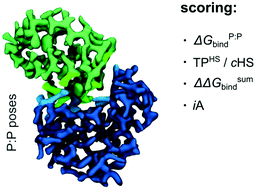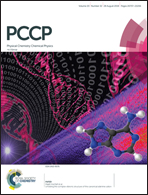Properties that rank protein:protein docking poses with high accuracy†
Abstract
The development of docking algorithms to predict near-native structures of protein:protein complexes from the structure of the isolated monomers is of paramount importance for molecular biology and drug discovery. In this study, we assessed the capacity of the interfacial area of protein:protein complexes and of Molecular Mechanics–Poisson Boltzmann Surface Area (MM–PBSA)-derived properties, to rank docking poses. We used a set of 48 protein:protein complexes, and a total of 67 docking experiments distributed among bound:bound, bound:unbound, and unbound:unbound test cases. The MM–PBSA binding free energy of protein monomers has been shown to be very convenient to predict high-quality structures with a high success rate. In fact, considering solely the top-ranked pose of more than 200 docking solutions of each of 39 protein:protein complexes, the success rate was 77% in the prediction of high-quality poses, or 90% if considering high- or medium-quality poses. If considering high- or medium-quality poses as the top-one prediction, a success rate of 87% was obtained for a scoring scheme based on computational alanine scanning mutagenesis data. Such ranking accuracy highlights the ability of these properties to predict near-native poses in protein:protein docking.



 Please wait while we load your content...
Please wait while we load your content...